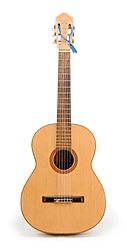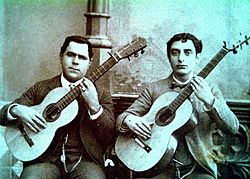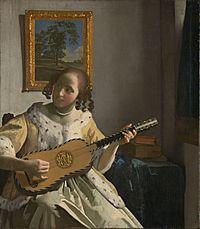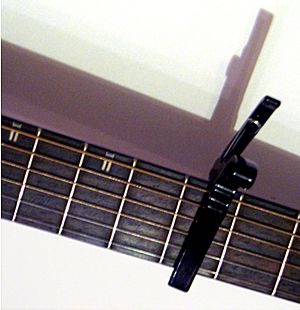Guitar facts for kids
 |
|
| String instrument | |
|---|---|
| Classification | String instrument (plucked, nylon stringed guitars usually played with fingerpicking, and steel-, etc. usually with a pick.) |
| Playing range | |
|
(a regularly tuned guitar)
|
|
| Related instruments | |
| Bowed and plucked string instruments | |

The guitar is a string instrument that you play by plucking its strings. The main parts of a guitar are the body, the fretboard, the headstock, and the strings. Guitars are usually made from wood or plastic. Their strings can be made of steel or nylon.
You can pluck the guitar strings with your fingers and fingernails. If you are left-handed, you might use your left hand. Many players also use a small plastic pick, called a "plectrum" or guitar pick. Your other hand holds the guitar's neck. By pressing your fingers on different spots on the fretboard, you can make different musical notes.
Instruments similar to the guitar have been around for thousands of years. Guitars have been very popular in many countries and at different times. This is because they are easy to carry and often simpler to learn than other instruments. Guitars are used in many types of music, from classical to rock. Most popular songs written since the 1950s use guitars.
There are many kinds of guitars. They are grouped by how they are made and the type of music they play. Most traditional guitars have a hollow body. This makes the sound of the strings louder and gives the guitar its special quality. This type of guitar is called "acoustic." An acoustic instrument makes its own sound without needing electricity.
Since the 1930s, people started making guitars that use electricity and amplifiers to control how loud they are. These guitars, often used in popular music, are called electric guitars. They don't need a hollow body because they use electricity to make the sound louder.
Most guitars have six strings. But you can also find guitars with four, seven, eight, ten, or twelve strings. More strings can make the instrument sound richer. The neck of a guitar has metal bars or marks called frets. Frets help a guitarist know where to place their fingers to get the correct pitch when playing.
Contents
What's in a Name?
The word guitar came into English from the Spanish word guitarra in the 1600s. In the Middle Ages, people in England used words like gitter or gittern. Both guitarra and gitter came from the Latin word cithara. The word cithara might have come from the earlier Greek word kithara. Kithara could even be from the Persian word sehtār.
A person who plays the guitar is called a guitarist. Someone who builds or fixes guitars is a luthier. This word comes from "lute", which is another stringed instrument. The word "lute" comes from the Arabic "Al-Uud," an instrument from the Middle East.
The guitar seems to have come from older instruments known as the Sitara in ancient central Asia. Instruments very much like the guitar can be seen in old carvings and statues from the ancient Iranian city of Susa. The word guitar was brought into Spanish when similar instruments were brought to Spain by the Moors after the 10th century.
Guitar History

Instruments similar to the guitar have existed for at least 5,000 years. The guitar might have come from older instruments like the sitara from ancient India and central Asia. The oldest known picture of a guitar-like instrument is a 3300-year-old stone carving of a Hittite musician.
The oldest complete guitar-like instrument still existing is the "Warwick Gittern" in the British Museum. It belonged to Elizabeth I of England and probably to her father Henry VIII before her. It is about 500 years old.
The design of the modern guitar started with the Roman cithara. The Romans brought the cithara to Spain around 40 AD. In the 8th century, the Moors brought the four-stringed oud to Spain. The oud's arrival changed the cithara's design.
In other parts of Europe, the six-string Scandinavian lut (lute) became popular wherever the Vikings had been. By 1200 AD, there were two types of four-string "guitars":
- The guitarra morisca (Moorish guitar) from Spain had a rounded back, a wide fingerboard, and several soundholes.
- The guitarra latina (Latin guitar) was more like the modern guitar, with one sound hole and a narrower neck.
The Spanish vihuela from the 16th century was another instrument similar to the guitar. It was tuned like a lute but had a body like a guitar. The vihuela was popular for only a short time.
The Vinaccia family from Naples, Italy, were famous mandolin makers. It is believed they also made the oldest six-string guitar that still exists. This guitar was signed and dated 1779 by Gaetano Vinaccia (1759 - after 1831). Experts believe this guitar is real, even though many fakes exist from that time.
The guitar's design was greatly improved by the famous Spanish luthier, Antonio Torres Jurado (1817-1892), and by Louis Panormo of London.
The electric guitar was invented by George Beauchamp in 1936. Beauchamp helped start a company called Rickenbacher to make guitars. However, Danelectro was the first company to produce electric guitars for everyone to buy.
Types of Guitars
Dr. Michael Kasha described a guitar as an instrument with "a long, fretted neck, flat wooden soundboard, ribs, and a flat back, most often with incurved sides."
Modern guitars come in four main types:
- The classical guitar is used for classical music.
- The term acoustic guitar usually refers to a guitar used for popular music. However, a classical guitar is also an acoustic instrument. There are many other types of acoustic guitars from different parts of the world.
- An electric guitar can be flat, hollow, or semi-hollow (solid with hollow parts inside). It makes sound using its pickups, which are wire-wound magnets attached to the guitar.
- Some guitars mix the hollow acoustic body with amplified sound.
- Bass guitars are designed to make a low, deep rhythm sound.
Guitar Music
Guitars are used in many different types of music. This includes traditional, regional, and folk music, as well as modern punk, rock, metal, and pop. Guitars can be used as rhythm instruments, lead instruments, or sometimes both at the same time.
What is a Capo?
A capo is a small device that you can place on any of the guitar's frets (the metal bars on the neck). This lets the player change the key of the song without having to change how the guitar strings are tuned. There are different kinds of capos. Some wrap around the whole guitar neck, and some just clamp onto the back and fretboard.
Related Pages
Images for kids
-
19th century guitar made by luthier Manuel de Soto held by Spanish guitarist Rafael Serrallet
-
Hofner 500/1 bass guitar, famous for being used by Sir Paul McCartney for almost 60 years
-
Sinéad O'Connor playing a Fender guitar with a capo
-
This Fender Stratocaster has common electric guitar features: multiple pickups, a vibrato bar/vibrato unit, and volume and tone knobs.
See also
 In Spanish: Guitarra para niños
In Spanish: Guitarra para niños















